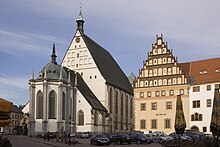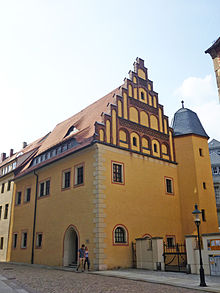City and Mining Museum Freiberg
The Freiberg City and Mining Museum, founded in 1861 by the Freiberg Antiquities Association in the former canon court, a late Gothic secular building, is one of the oldest civic museums in Saxony. It is headed by Andrea Riedel.
Exhibitions
- Freiberg mining
- Freiberg in the Middle Ages
- The late Gothic sacred art of Upper Saxony
- The Freiberg sculpture of the Renaissance
- Masterpieces of mining art
- Freiberg at the turn of the Middle Ages to the modern age
- Treasures from the collections
- Freiberg in the 19th century
In addition to the exhibitions, the museum houses extensive pieces of late Gothic sculpture, an important collection of historical edged weapons and firearms as well as Upper Saxon handicrafts in its stored collection. The graphics collection includes the graphic estate of Johann Christian Klengel and the painterly estate of Hugo Koerber . The museum's photo library includes a. about glass negatives by the photographer Reymann with buildings and street views of the city as well as extremely valuable shots of everyday life and the work process of the miners.
Building history
Despite the extensive renovation in 1899/1901, the late Gothic corner building in which the museum's exhibition rooms are today has been largely preserved. A presumable predecessor of today's museum fell victim to the great fire in 1484. The current building at Am Dom 1 was built after 1484. It was documented as existing as early as 1488. This agrees with the stylistic classification of existing building details. A hexagonal stair tower , which was raised in 1588, adjoins the street-side south facade . The windows of the two street-side facades on the ground floor and partly on the 2nd floor consist of late Gothic arched curtain windows with slender, intersecting valley bars and rectangular windows , especially on the 1st floor. The ornamental gable facing the Untermarkt and the plaster friezes on the two façades, documented in drawings, were partially reconstructed during the renovation around 1900.
Inside there are several rooms with cell vaults on the ground floor and heavily profiled wooden beam ceilings with remains of late Gothic frames on the first floor, fragments of late Gothic wall paintings on the ground floor and a triple grooved rectangular portal.
The house initially served as the residence of the clergy in the Marienkirche, which was raised to the rank of collegiate monastery in 1480 , and is now the cathedral . The so-called Domherrenhof also included the buildings Am Dom 2 and 4 , Untermarkt 1 and possibly also the house at Domgasse 6 . In the most elegant house, however, the dean lived with his vicars and chaplains . After the Lutheran Reformation, the collegiate monastery was dissolved and the city made the building available to the Latin school in 1542 . It now served as a school and as a residence for the principal, other teachers and students in need. In 1875 the grammar school, which had emerged from the Latin school, moved into a newly built functional building. The building then served partly as living space, partly as a warehouse and production facility for the Hoppe woolen goods factory.
Museum history
In 1860, history-conscious citizens founded the Freiberg Altertumsverein under the direction of the book printer's owner Heinrich Gerlach, which collected a wealth of historical objects and originally exhibited them in the box room of the municipal department store on Obermarkt (Obermarkt 16). Due to cramped conditions, the association moved in 1903 to today's specially renovated museum building on Untermarkt .
On May 7, 1903, the museum was inaugurated in the presence of the Saxon King Georg and was named King Albert Museum . The Antiquities Association then intensified its collecting activities and closed large gaps in the collection of objects from mining and folklore objects.
Since then, research by the association has been published in the publication series "Messages from the Freiberg Altertumsverein". The photographic documentation of buildings and landscapes suggested by the association now forms the basis for the museum's extensive photo collection. In accordance with the principles of the time, all collection items were displayed in the exhibitions, so no museum depots were used yet .
In 1926 the museum was redesigned, the collections scientifically structured and depots set up. A high point in the museum's history was the “750 Years of German Ore Mining” exhibition in 1938 as part of Freiberg's 750th anniversary. In order to accommodate the special show, all permanent exhibitions in the building had to be cleared. In addition, a three-sided arcade was built in the courtyard area of the Am Dom 1 and 2 buildings . On January 1, 1939, for financial reasons, the museum was completely taken over by the city and given the name City and Mining Museum , which programmatically expressed the content and profile of the museum.
During the Second World War some of the collections were outsourced. Towards the end of the war, the Wehrmacht set up the warehouse of an army medical park in the museum building. After the war, the museum was used by the Soviet occupying forces as a radio collection point and tire store for a short time. The first special exhibition was opened in February 1946, and the entire museum on November 24, 1946. Since the 1950s, some construction work has been carried out on the museum buildings and, after 1990, a complete renovation.
Ulrich Thiel has headed the museum since 1989. Due to differences due to the new museum concept decided by the city in July 2017 and the planned sale of the canons' houses Am Dom 2 and 3 used as a storage facility, Thiel retired on January 31, 2018. Andrea Riedel was appointed as the new head.
literature
- Ulrich Thiel: The City and Mining Museum , Freiberg 1997 (leaflet from the series “Monuments in Freiberg”).
- Ulrich Thiel: The Freiberg City and Mining Museum between continuity and change , In: Informations des Sächsisches Museumsbundes eV, No. 14/1997, pp. 19-20.
- Ulrich Thiel: Freiberg City and Mining Museum , Regensburg 2001 (= Schnell-Kunstführer 2438).
- Ulrich Thiel: Freiberg City and Mining Museum , Saxon Museums, Volume 17, 2005.
- Gunther Galinsky (Ed.): Reymann . Photo documentarists in the mountain town of Freiberg 1865–1945. 2nd improved edition. Fotokinoverlag, Leipzig 1988, ISBN 3-7311-0003-7 .
Web links
- Literature from and about the Freiberg City and Mining Museum in the catalog of the German National Library
- City and Mining Museum Freiberg
Individual evidence
- ↑ Andrea Riedel is the new director of the City and Mining Museum. In: freiberg.de. September 8, 2017, accessed March 10, 2018 .
- ^ Yves Hoffmann, Uwe Richter: Origin and bloom of the city of Freiberg. The structural development of the mountain town from the 12th to the end of the 17th century . Mitteldeutscher Verlag, Halle (Saale) 2012, ISBN 978-3-89812-930-5 . P. 458.
- ↑ Ulrich Thiel: Stadt- und Bergbaumuseum Freiberg , Sächsische Museen, Volume 17, 2005, pp. 38–42.
- ^ Ulrich Thiel: Stadt- und Bergbaumuseum Freiberg , Sächsische Museen, Volume 17, 2005, pp. 46–56.
- ↑ "I hope she has a bonus": Director Ulrich Thiel leaves the Freiberg City and Mining Museum with a grudge - successor Andrea Riedel: "Fine-tuning the concept" , Freie Presse , January 17, 2018
- ↑ Andrea Riedel is the new director of the City and Mining Museum , City of Freiberg
Coordinates: 50 ° 55 ′ 13.8 ″ N , 13 ° 20 ′ 38.3 ″ E




